Orthodontics is a specialisation of dentistry which deals with the treatment of malocclusion and is usually identified with the improvement of smile aesthetics. In reality, the aim of orthodontic treatment is to restore proper functions, which include biting and grinding food, or to improve pronunciation.
Orthodontic treatment is becoming more widely used as improving the alignment of teeth can often reduce the risk of trauma, eliminate tooth overload that can lead to early tooth loss, as well as improve chewing function and facilitate tooth cleaning. Orthodontic treatment extends to both children and adult patients.
WHY IS IT WORTH WEARING ORTHODONTIC BRACES?
A healthy and pretty smile is the business card of every person. Wearing braces is the main part of the orthodontic treatment process, which results in the correction of malocclusion. Braces make it possible to maintain healthy teeth, cure some speech defects and maintain the comfort of oral cavity. Straight teeth are less prone to caries and periodontal diseases, therefore it is worth considering having braces fitted from an early age.
HOW LONG DOES BRACES TREATMENT LAST?
The duration of treatment with braces depends on the severity and complexity of the patient’s malocclusion. Depending on the treatment method and the type of braces, it ranges from several months to several years.
WHO CAN WEAR BRACES?
There is no specific age limit for treatment with braces. Therefore, anyone may have their bite corrected – both children with milk teeth (removable braces) and teenagers and adults with permanent teeth (fixed braces).
IS ORTHODONTIC TREATMENT PAINFUL?
Treatment of dental defects with fixed or removable braces is usually painless. However, there may be situations when the patient feels discomfort, but this usually lasts a few days at the most. However, it is an individual matter and depends on the patient’s resistance to pain.
STAGES OF ORTHODONTIC TREATMENT
CONSULTATION, is the first step, which is one of the most important moments of the treatment. The orthodontist gets to know the patient, verifies the current state of occlusion and examines whether there are any contraindications to orthodontic treatment.
- Before starting the orthodontic treatment, the patient goes through a thorough orthodontic diagnostics. Two X-rays are taken: pantomographic and cephalometric, as well as intraoral and extraoral photographs.
- Another important element that will be performed at this stage of treatment is the scanning of teeth with a modern scanner. Thanks to the iTero scanner we are very relieved to say goodbye to the era of traditional impressions in favour of digital impressions which are necessary to design the appropriate type of braces.
SEE MORE: https://www.cyfrowa-ortodoncja.pl/skaner-itero/
PRESENTATION OF THE TREATMENT PLAN
The treatment plan illustrates exactly what actions will be performed by the doctor throughout the treatment process. For the orthodontist, this is a key task in which he or she determines the sequence of steps in the orthodontic treatment process to achieve the best possible result.
The doctor presents the patient with all the available solutions that can be used for the orthodontic defect in question.
After choosing the appropriate braces, the next stage of treatment takes place.
FITTING OF CORRECTIVE BRACES
The visit takes about one and a half hours. The time of the visit consists of familiarising the patient with the informed consent form for orthodontic treatment, signing the agreement and fitting the selected braces.
After the braces are fitted, the patient receives recommendations concerning proper oral hygiene.
FOLLOW-UP VISITS
Follow-up visits take place from 6 to 7 weeks, depending on the type of braces. In the case of selfligating braces, even less frequent – from 8 to 9 weeks.
During the visits the date of bonding the braces on the other tooth arch and further treatment steps are also determined.
HOW TO TAKE CARE OF ORAL HYGIENE WHILE WEARING BRACES?
While wearing orthodontic braces, you should follow the rules of oral hygiene. First of all, the patient should:
- carefully clean the surface of the teeth with toothbrushes, toothpastes and liquids, follow the orthodontist’s recommendations,
- do not eat hard foods,
- avoid sweets that are chewy and sticky to the teeth,
- give up caries-producing products
- visit a professional dental hygienist in order to choose appropriate accessories for oral hygiene and perform regular hygienic treatment.


